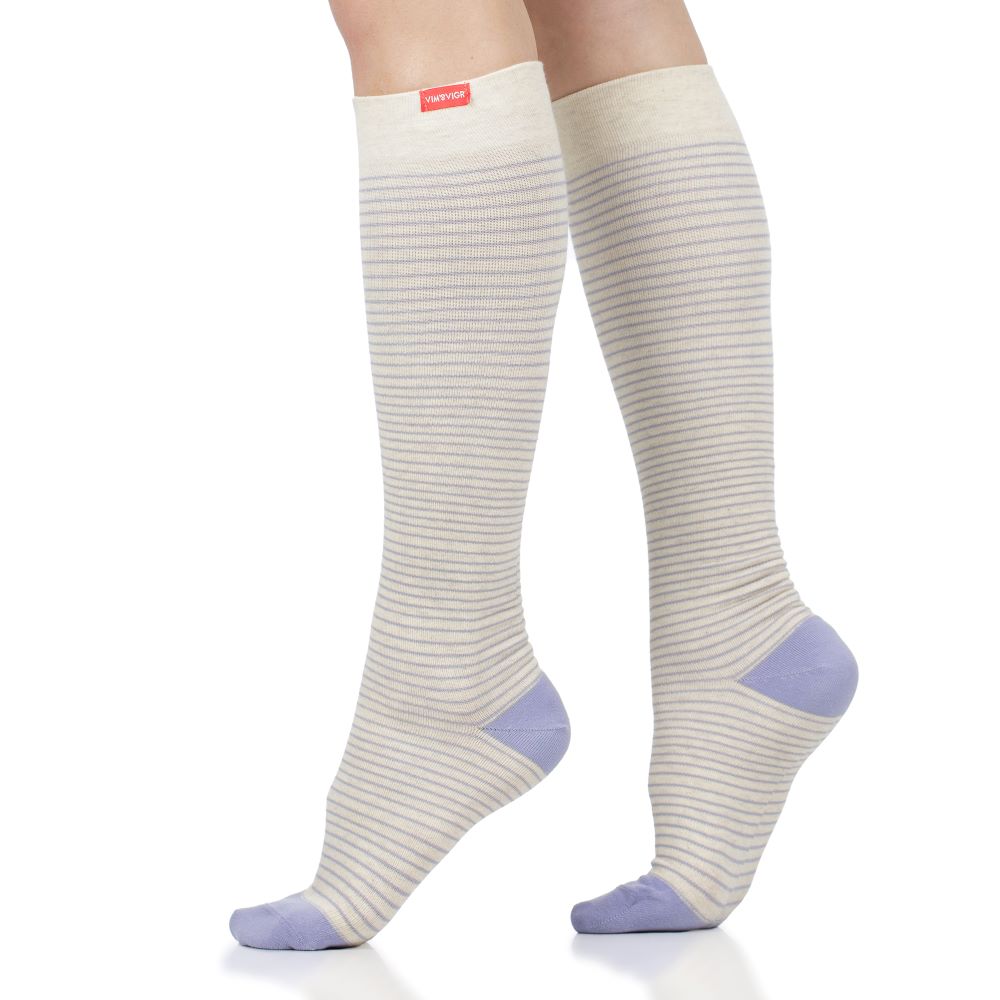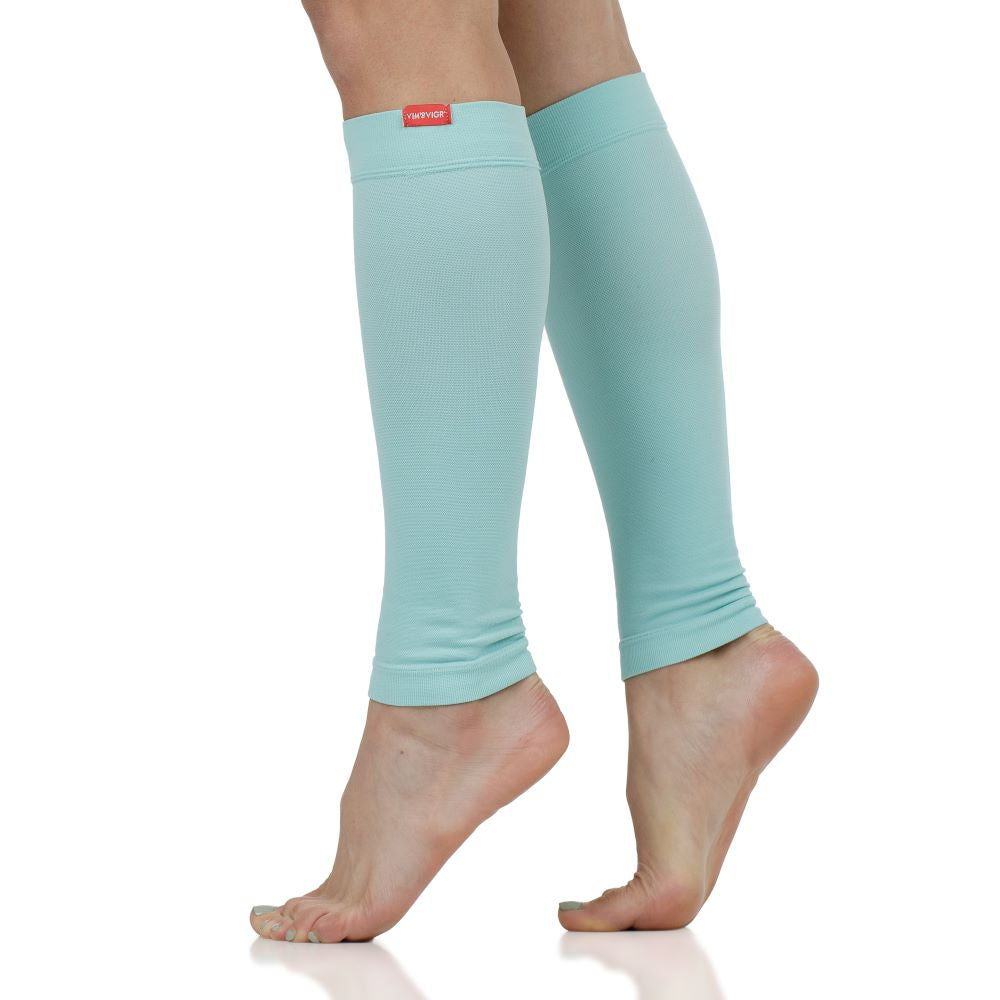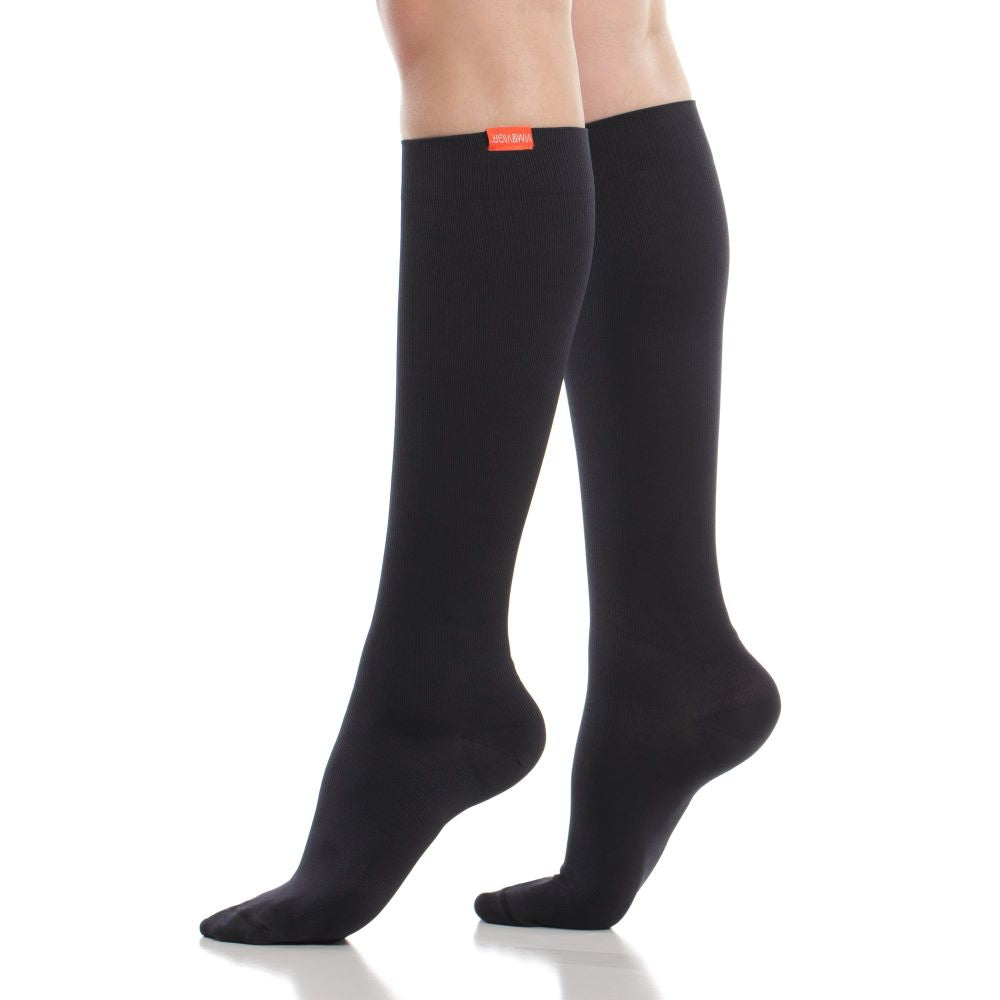How Compression Socks Work & Why They're Beneficial
With growing awareness of how people can benefit from wearing compression socks, the market and the popularity of these items has grown steadily and is only set to continue. They make your legs feel lighter and decrease swelling, while also providing long term health benefits to those struggling with blood circulation in their lower limbs.
So, how do compression socks work their magic and why are they a great tool for preventing blood clots, DVT or other conditions? And how do they help athletes and those looking to recover from physical exercise?
In this article, learn the science behind how compression socks work to improve blood circulation, aid recovery after exercise and relieve unpleasant symptoms in the lower limbs.
What Are Compression Socks?
Compression socks and stockings are known as specialized hosiery designed to compress, or apply pressure to, the lower limbs. The main purpose of medically prescribed compression socks is to improve blood circulation in order to avoid various vein-related conditions such as edema, deep vein thrombosis or blood clots.
In a nutshell, good quality compression socks are made from a variety of fabrics and come in a range of pressure levels. These show how much compression will be applied to your legs, from lightest (15-20 mmHg) to the strongest (30-40 mmHg, usually prescribed by a medical professional).
How Do Compression Socks Work?
Through compression of the lower limbs, these specialized socks apply pressure to the legs and ankles, helping to stimulate good blood flow in the area. Most compression socks are graduated, which means that more pressure is applied at the bottom (ankle area), then gradually it becomes lighter as you move up towards the knee.
As a result, compression socks prevent blood from pooling around the bottom of your legs and possibly creating blood clots. This also means they reduce any swelling or discomfort caused by spending a long time without moving, either on your feet or sitting down (for example, during a long-haul flight).
Finally, compression socks apply a level of pressure that is also supportive of the muscle. By wearing them when you’re running or hiking, you’re increasing protection to your calf muscles, shins and ankles, both from external factors like getting scraped and grazed, and from vibrations to the muscle. For some people, the support offered by compression socks feels beneficial during recovery from ankle or calf sprains, too.

What Do Compression Socks Do?
Compression socks apply gentle, gradual pressure to the lower legs. This helps maintain healthy blood flow and reduce swelling caused by inactivity or long time spent on feet.
Since they promote healthy blood circulation, compression socks also help with recovery after effort. This is thanks to the fact that blood moves through the muscles more effectively, transporting oxygen that helps muscle rebuild after working out.
By improving circulation, compression socks can help decrease the risk of developing blood clots, DVT and other conditions. They are also of great help during pregnancy, making legs feel lighter and less uncomfortable overall.
What is the Science Behind Graduated Compression Socks?
Compression applied to the venous system has been shown to support better blood flow. In the case of graduated compression, this works by pushing the blood back up from the legs towards the heart, which is essential for avoiding swelling, blood clots, and other related conditions.
To understand the science behind graduated compression, we need to first understand how the circulatory system works. The heart pumps out blood to the lungs, where oxygen is collected. This then travels throughout the body, to organs, tissues and muscles through the arteries. The veins subsequently carry the oxygen-poor blood back to the heart, starting the process back again. [1]
If the veins become blocked (e.g. by blood clots) or if the overall circulation stagnates, then the body can become swollen and heavy, as we observe after long flights where we don’t move for several hours at a time, for example. This is where graduated compression comes in. By applying more pressure to the lower end of your legs and less towards the top, compression socks help support the valves inside your blood vessels, helping to move blood back up towards the heart.
This can reduce swelling and discomfort while also decreasing the risk of developing more serious conditions such as deep vein thrombosis. Overall, graduated compression socks are an effective tool for improving circulation and reducing swelling in individuals who spend long periods of time on their feet or sitting down for extended periods during travel.

What Are Compression Socks Used For?
You can use compression socks in lots of different scenarios, depending on your experience and medical condition. Most often, compression socks can be extremely beneficial to those travelling for a long period of time (on a long flight or car journey, for example), as well as to professions like nurses or sales people (who spend almost all of their time on their feet).
Here are some top situations where compression socks can be of use:
- If you stand or sit all day at work;
- During pregnancy, especially to counteract swelling or conditions like restless leg syndrome;
- For running or hiking in all types of weather conditions;
- After exercise, to support muscle recovery and relieve aching limbs;
- If you struggle to sleep well, compression socks have been linked with better sleep quality and reduced sleep apnea;
- When recovering from a sprain or strain;
- During recovery from surgery - this is often recommended by doctors to prevent DVT or blood clots in bedridden patients.
Ultimately, you can also wear compression socks as a fashionable accessory to keep your legs feeling fresh and energized at work, in casual settings or during exercise. Really, there’s no limit as to what you can use them for.
How Long Does It Take for Compression Socks to Work?
The benefits of wearing compression socks depend on various factors, including your medical condition and the reason you’re wearing them in the first place. In general, it's recommended that compression socks be worn for at least several hours each day to see their full benefits. For most people, a decrease in swelling can be observed after these first few hours, but a general improvement in blood circulation will take a few days.
For athletes, it may take a few days of wearing compression socks during training sessions and recovery periods before they notice a difference in their muscle fatigue and soreness. For patients with venous insufficiency or other conditions that cause swelling or pain in the legs, it may take a few weeks of consistent wear to see a reduction in symptoms.
Regardless of your situation, it's important to note that compression socks are not a cure for any underlying conditions, but rather a way to manage symptoms and improve circulation. If you have a medical condition, it's important to consult with a healthcare professional before using compression socks to determine if they are right for you and how long you should wear them.
Who Should Wear Compression Socks?
There are no immediate harmful side effects from wearing good quality compression socks, as long as you have the right size and are wearing them correctly. [2] Therefore, whether worn for recovery, relief from swelling, or simply for esthetic purposes, compression socks are accessible to most people.
Here are some situations where compression socks will bring you the most benefit:
- If you need to sit or stand for long periods of time at work, for example as a nurse;
- If you drive long distances - e.g. professional truck drivers;
- As a runner, you can wear compression socks to promote good blood flow during exercise and to speed up recovery afterwards;
- For long hikes, in all types of weather, a good pair of Merino wool compression socks not only offer support to the lower limbs, but they keep you cool and dry regardless of the temperatures;
- People at risk of developing blood clots, DVT, or varicose veins;
- When you are bedridden or recovering from surgery;
- During pregnancy.

Who Should Not Wear Compression Socks?
The biggest possible issue with compression socks is wearing them incorrectly. This means either choosing the wrong size, which can lead to them rolling down or being too tight, or wearing inappropriate fabrics for your activity. You might also end up wearing compression socks at a level that’s just too high for you, especially when you’re wearing them for the first time.
However, we recommend checking with a doctor before wearing compression socks if you suspect you might have a medical condition that could make them dangerous for you. For example, people with peripheral vascular disease affecting their lower extremities should not wear compression socks because they can make it worse. Also known as ischaemia, this is a lack of oxygen in the limbs which can make walking painful when arteries are narrowed or blocked, and the muscles cannot get enough oxygen.
Some people may be allergic to certain materials in compression socks. This is why it’s important to check the label and choose the fabric that best works for you. You may not be able to wear Nylon socks, but Merino wool socks are usually ok for most people thanks to the hypoallergenic nature of the material.
Choose Compression Socks That Work For You
Ultimately, wearing compression socks will give you the most benefits if they’re the right item for your current condition and if you’ve chosen the correct size, pressure levels and materials for your situation and activity levels.
We recommend always checking with a medical specialist if you have any doubts around wearing compression socks. If you’re all clear, then there are so many options waiting for you in our catalog - have a look!



















Leave a comment